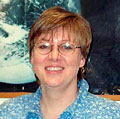 |
|
|
| Author |
Message |
Patty_Cie

Joined: 23 Mar 2004
Posts: 87

|
 Posted:
Fri Jun 11, 2004 5:50 pm Posted:
Fri Jun 11, 2004 5:50 pm |
  |
June 7, 2004 Monday
10:00 PM Alaska time
We continue to travel east and have entered an impressive field of ice rubble. There is more sediment trapped in the ice than we have seen since the beginning of the cruise and that makes Laura Belicka and Rachael Rearick very happy. They would very much like to collect sediment from the ice, but finding ice that is thick and stable enough to stand on and having enough sediment content is a tricky combination.
Laura and Rachael are technicians for a project titled, “Molecular Biomarkers As Tracers Of Carbon Source and Transport in the Western Arctic Ocean.” Their project’s principle investigator is Rodger Harvey from Chesapeake Biological Laboratory, University of Maryland’s Center for Environmental Science. Their goal is to investigate where carbon is coming from, how much there is, and where it is going by looking at lipid biomarkers. Lipids are fats and oils that help give living cells their structure. Through lipids, they can tell how much of the carbon came from the marine environment and how much came from the land (terrestrial) environment. Different types of cells have different lipids and, therefore, can be used to determine where the carbon source originated such as terrestrial plant material or marine diatoms, etc.
To gather samples, they collect 50 liters of water into large plastic containers from the CTD at three depths:
1. Shallow at the chlorophyll maximum
2. At the halocline (a depth where the salinity concentration changes causing a density difference between water layers)
3. The deepest part of the cast
They filter the 50-liter samples through a 0.7-micron GF/F filter. The filter is then frozen at –20 degree Celsius and taken back to the University of Maryland for lipid analysis at the end of the cruise.

Rachael is filtering water for water column particles.
Laura is also looking at lipids from benthic samples taken by a box coring technique. During the 2002 SBI cruises, many box core samples were gathered from the Arctic shelves. She hopes to add to their data by collecting deep basin samples during the spring and summer 2004 SBI cruises. It has been a challenge getting to the deep basin this spring. So far, she has collected only one box core sample.

Collecting benthic samples can be dirty business. Mustang suits must be washed off before re-entering the lab area. The box corer can be seen on the right.
In addition to lipids analysis which shows how the input of carbon has changed over time, Laura will have the benthic samples dated using radioactive carbon dating techniques so she may have an indication of how old the sediment is. A previous carbon dating analysis estimated the bottom layer of one 20 cm deep-basin sediment to be 9000 years old. It may be possible that deep basin, benthic sediment may provide a timeline back through Earth’s history much in the fashion of ice cores and tree rings.

The box core sample must be sliced into thin layers. Rachael Rearick is in the front. Laura Belicka and Craig Aumack are in the back.
Additionally, Rachael is performing experiments with bacteria in collaboration with Dr. Dave Kirchman from the University of Delaware, College of Marine Studies. To give a greater confidence level to her data, Rachael does all her experiments in duplicate. First, while on station, she collects approximately 200 liters of water into four 50-liter plastic carboys from the active seawater system at the 8.3 meter depth. Next, she filters water from the 50 L bottles to 20 L bottles using a 1-micron filter. She refilters the water using a 0.2-micron filter to remove all protists.
Then, Rachael sets up a control and three treatments. For the control, she adds 18 liters of the 0.2 micron-filtered water to 2 liters of 1.0 micron-filtered water. To the first treatment, she adds three grams peat from the Ikpikpuk River in Alaska to 18 liters of 0.2 micron-filtered water. To the second treatment, she adds 0.8 grams of wet ice algae to 18 liters of 0.2 micron-filtered water. To the third treatment, she adds 18 grams of wet ice debris to 18 liters of 0.2 micron-filtered water. The bacteria are allowed to grow and are counted by staining the bacteria and counting them under a microscope.
(To Yelm Middle School students: Can you identify one of the controlled variables, the manipulated variable and the responding variable in Rachael’s experiment?)
She is trying to look at whether or not bacteria can consume different types of carbon and, if so, what species of bacteria are utilizing the carbon. To determine species, Rachael uses fluorescence in situ hybridization and DNA analysis. She also looks to see if the composition of the bacterial membrane lipids changes due to the carbon intake. Furthermore, she can do compound specific isotope analysis on individual lipids to determine which lipids were synthesized using which substrate. As the polar icecaps recede, more terrestrial peat will be added to the marine environment. With Rachael’s work, we will know if the peat will be incorporated into the food chain through bacteria. |
|
|
    |
 |
|
|
|
View next topic
View previous topic
You cannot post new topics in this forum
You cannot reply to topics in this forum
You cannot edit your posts in this forum
You cannot delete your posts in this forum
You cannot vote in polls in this forum
You cannot attach files in this forum
You can download files in this forum
|
Powered by phpBB 2.0.11
© 2001, 2002 phpBB Group :: FI Theme ::
All times are GMT
| |
